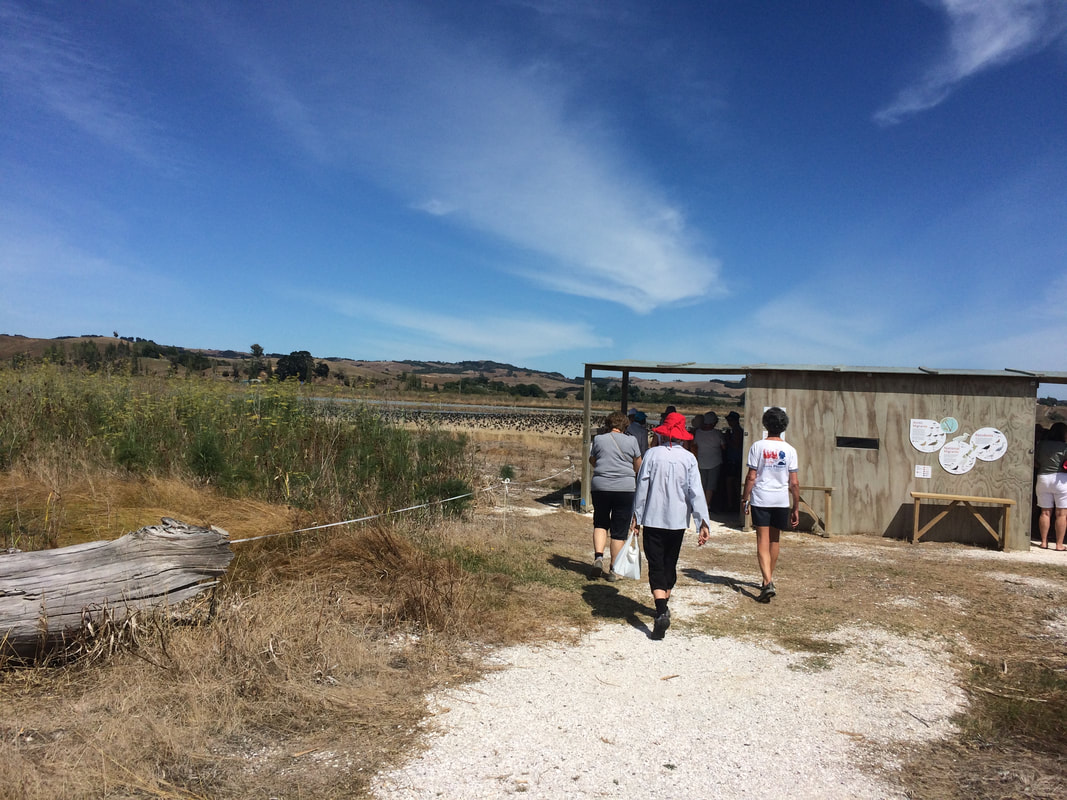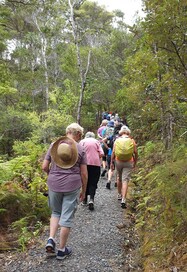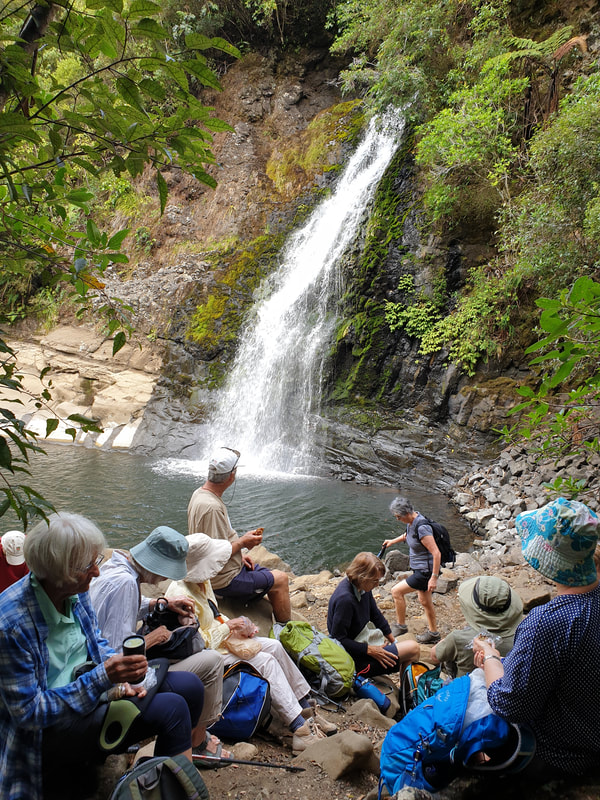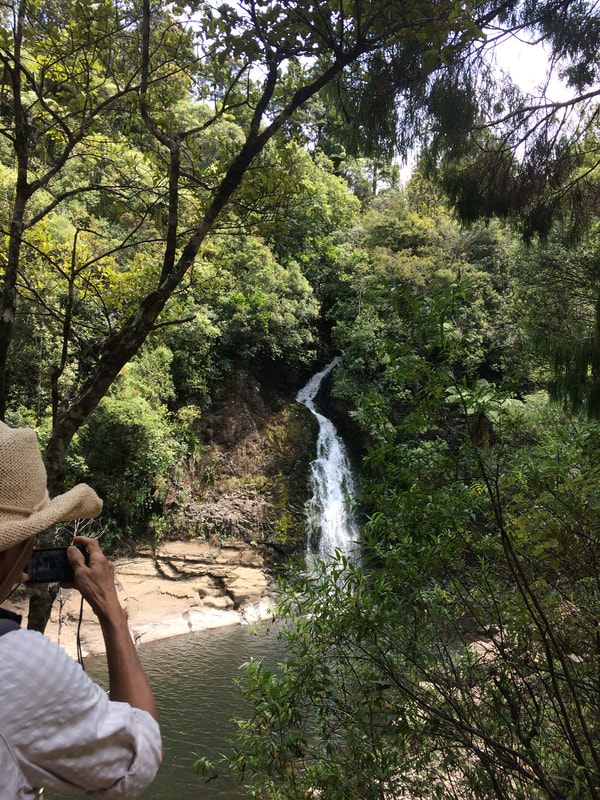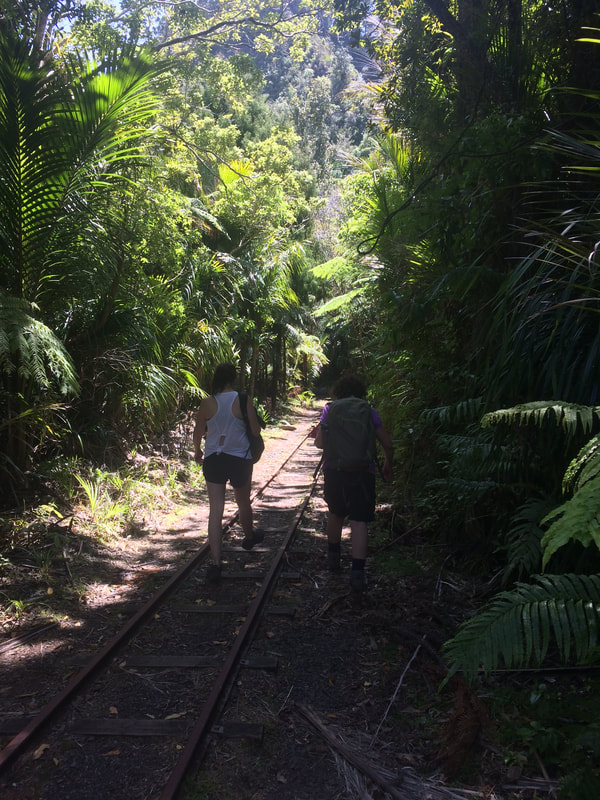Trip Reports : February - March 2020
01 March - Miranda Shorebird Centre and Waharau Regional Park
When we set off with 35 walkers, it seemed that many of our group had not been to the Miranda Shorebird Centre before, so there was much anticipation on the part of the first –time visitors.
(Prior to that, our Club had paid a visit there in 2014.)
(Prior to that, our Club had paid a visit there in 2014.)
 All about Miranda's shorebirds
All about Miranda's shorebirds
The day started with a most illuminating talk from Keith, the resident expert at Miranda. He not only described the habits of the birds we would see, but explained why events occured in the way they did.
Who knew that when the godwits return on their non-stop flight from Alaska, that the birds had a “waiting period” on reaching their feeding place in New Zealand, so that they could shed their worn down flight feathers and replace them? Or that each group of birds always comes and goes from the same location in New Zealand year after year?
The day started with a most illuminating talk from Keith, the resident expert at Miranda. He not only described the habits of the birds we would see, but explained why events occured in the way they did.
Who knew that when the godwits return on their non-stop flight from Alaska, that the birds had a “waiting period” on reaching their feeding place in New Zealand, so that they could shed their worn down flight feathers and replace them? Or that each group of birds always comes and goes from the same location in New Zealand year after year?
After the talk, we were lent two telescopic lenses to take to the bird hides and another expert, Alan, came with us to show us how to use them! Those who used digital cameras or phone cameras found that the telescopic lenses showed us far more than our cameras could. At the first hide, there was already another staff member from the Centre, ready with telescope trained on two flocks of birds.
At the next hide we could identify large flocks of oystercatchers, godwits (almost ready for take-off to Alaska) and wrybills. Further away we could also identify a few curlews, more oystercatchers and even further were some spoonbills, but they were not co-operating today: they stood still and did not demonstrate their head-swinging search for food in the shallow water.
The information displayed on the boards along the way was also noteworthy, one even gave a short history of the area.
Returning the precious telescopic lenses and Alan safely to the Shorebird Centre, we headed for Waharau Regional Park, our lunch stop. Following lunch (with two kereru perched above us!) we headed down to the start of the “Bush Track,” a short but very pleasant loop walk. The longer tracks had been closed in order to prevent the spread of phytophthora (kauri dieback).
Returning the precious telescopic lenses and Alan safely to the Shorebird Centre, we headed for Waharau Regional Park, our lunch stop. Following lunch (with two kereru perched above us!) we headed down to the start of the “Bush Track,” a short but very pleasant loop walk. The longer tracks had been closed in order to prevent the spread of phytophthora (kauri dieback).
At the start of the track, we used the “brush and spray” station first, then enjoyed the cool air in the bush, even for the short time it took to do the loop walk. There were quite a few birds here; tui and fantails were seen and not just heard. The trees here were nearly all natives: tanekaha, young kauri well away from the track, taraire, various ponga trees, etc.
Then, spraying our shoes again (thank you Eina, one of our newest members), we were out of the bush and heading for ice creams at the Pink Ice Cream Shop along the road.
Thanks to leaders Praemi and Margaret, also to Elizabeth for helping with the recce at short notice.
Text: Praemi; Photos: Linda, Sharleen and Praemi.
Text: Praemi; Photos: Linda, Sharleen and Praemi.
16 February - Tanekaha Falls and Forest - Brynderwyns
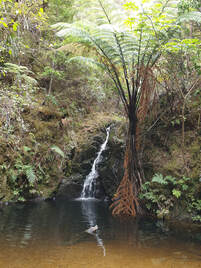 No rain for 40 days!
No rain for 40 days!
By taking the road from Kaiwaka towards Mangawhai and then heading left into the hills, Tanekaha Forest Park can be found nestled into the foothills of the Brynderwyn Ranges.
Our group planned to walk the Falls Track, Botanical Track and part of the Forest Track, all developed and maintained by the Mangawhai Tracks Charitable Trust.
These are great tracks for summer walking but can be muddy and slippery in winter.

With no threat of rain and under a light cloud cover we started our walk, leaving our bus parked at the road entrance to the park. We walked down the access road, hopped over a stile, sprayed our boots and trotted over the little swinging bridge to the grassy area on the other side.
In these pleasant surroundings we had morning tea, looked at the notice board showing a clear map of our intended walks and then divided into two groups. A and B.
In these pleasant surroundings we had morning tea, looked at the notice board showing a clear map of our intended walks and then divided into two groups. A and B.
Both groups took the Falls Track with the A group setting off first. After 45 minutes walking alongside the stream and through groves of ferns and nikau, they reached the first waterfall of the park, which proved to be an ideal spot for having lunch.
From here the A group continued on the Falls Track, then turned right onto the Botanical Track which climbed to offer the occasional view over the region. Small colourful information panels referring to native trees such nikau, kanuka, and rewa rewa, were attached to the appropriate trees to assist anyone wanting to identify them. As we had read about tanehaka and had looked at photos while travelling on the bus that morning, we were able to recognize the stands of these trees on the Botanical Track. (Thank you Praemi for the info).
To complete the loop of our walk we again turned right, this time onto the Forest Track which brought us back to where we had started earlier in the day. It was pleasing to see alongside this track that despite the dry conditions, young tanekaha trees were beginning to grow.
The B group also lunched at the first waterfall having enjoyed a more leisurely pace to get there. While the A group completed their loop walk, the others took the opportunity to relax, take in the scenery, explore a little and listen for birds, before their return trip back. Some walkers then ventured in on the Forest Track to meet the A group as they descended.
A quick stop in Mangawhai before the drive back to Auckland was appreciated, letting the hungry and the thirsty have time for coffee, ice creams and a visit to the Bennetts chocolate shop and café. Driver, Lyndon, thoughtfully took us into Mangawhai via the scenic route so we could see the amazing new developments taking place in the area.
Thank you to leaders Sharleen and Fiona for a great day in the bush!
Text: Fiona
Photos: Sharleen & Fiona
Thank you to leaders Sharleen and Fiona for a great day in the bush!
Text: Fiona
Photos: Sharleen & Fiona
2 February 2020 - Upper Nihotupu Dam Walk and West Lynn Garden
The narrow, winding roads heading into the Waitakeres are certainly a challenge for the driver of a large bus! However, a good start for the first walk of the year – 36 passengers arrived safely at the starting point of the trail leading down to the Upper Nihotupu Dam. Well done driver, Oki.
 Relics on the track
Relics on the track
With 36 pairs of boots sprayed at the cleaning station, we made our way into the thick, cool forest. The coverage was certainly appreciated on this very warm summer morning as there was a short climb to the gravel service road (used by Watercare) that would take us towards the dam.
The walk is probably best described as “very pleasant”. Mature native trees providing shade, a stream, two waterfalls and serene reservoir lake views. It’s not until you see the dam in the distance that you remember there is more to this location than just “nature at its best”.

The city purchased catchment land during the early 1900s, following recommendations to develop water supply dams in these high rainfall areas. The first dams were wooden (often washed away and having to be replaced), and water from the Waitakere Ranges was first supplied to the city in 1902.
The city purchased catchment land during the early 1900s, following recommendations to develop water supply dams in these high rainfall areas. The first dams were wooden (often washed away and having to be replaced), and water from the Waitakere Ranges was first supplied to the city in 1902.
Construction of the Upper Nihotupu Dam commenced in 1915 but difficult geological problems caused huge delays. An auxiliary dam was put in to alleviate the city’s chronic water shortage, and the Upper Nihotupu was finally completed in 1923.
We made our way across the top of the dam, checking out the plaque and signage, the views and the scale of the dam. It stands 50.3 metres tall and has a capacity of 2.2 gigalitres!
 Shirley on the track
Shirley on the track
The top of the dam was also a great vantage point for Praemi to point out how the rewarewa is a tree that stands out in the bush, stretching its arms high above many of the smaller trees, and how its botanical name Knightia excelsa, (meaning “excellent knight”) reflects this.
Back onto the service road for a further 10 minutes, we descended to the start of the tram track walk.
A bush tram was built (narrow gauge tramlines) to assist with the construction of the dam. Subsequently, Watercare ran the “Rainforest Express” sightseeing excursions for 15 years on the tracks. But, sadly, because of significant geotechnical instability and regular rock falls, the track was permanently closed in 2014.
Back onto the service road for a further 10 minutes, we descended to the start of the tram track walk.
A bush tram was built (narrow gauge tramlines) to assist with the construction of the dam. Subsequently, Watercare ran the “Rainforest Express” sightseeing excursions for 15 years on the tracks. But, sadly, because of significant geotechnical instability and regular rock falls, the track was permanently closed in 2014.
However, it isn’t closed to walkers and we enjoyed our stroll along the tracks to the bottom of the dam. We were appreciative of the shade along the way and awestruck by the enormity of the 50 metre concrete wall that came into view as we approached the dam.
|
We didn’t take the shortcut back to the top of the dam (a very vertical stepladder), but rather returned the way we had come. After a stop for lunch at the covered picnic area, we returned up the gravel service road to the top of the dam and then back along the reservoir, pausing many times to reacquaint ourselves with the waterfalls and pleasant views that we had previously admired on our way in to the dam. All 36 pairs of boots were re-scrubbed and sprayed before we headed off to our next stop. The chatter on the bus would suggest that everyone had thoroughly enjoyed the walk. |
West Lynn Garden

We enjoyed afternoon tea in the function centre (air conditioned!), before making our way into the grounds.
The garden holds a collection of 50 heritage listed trees, both native and imported, including rewarewa, golden totara, kauri and kawaka. The maturity and size of the trees made it possible to wander the gardens mainly in the shade.
The highlight of our visit would have to be the monarch butterflies. Monarchs in abundance in the butterfly house! What an amazing sight. Cameras were all out clicking furiously. A fantastic way to end our day.

Thanks to:
Leaders: Molly, Linda and Bev.
Text: Linda
Photos: Sharleen, Praemi and Linda
And, a very special thanks to the 36 walkers
who joined us on our first walk for 2020!
